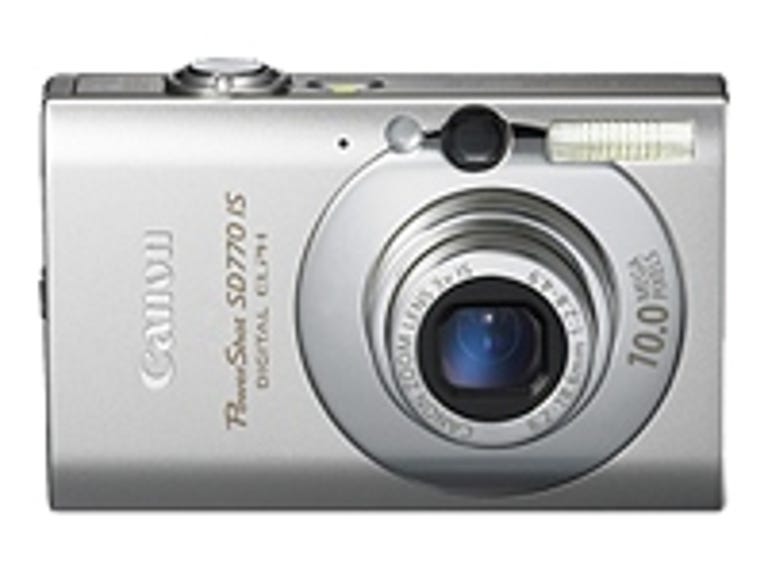 Why You Can Trust CNET
Why You Can Trust CNET Canon PowerShot SD770 IS review: Canon PowerShot SD770 IS
Canon PowerShot SD770 IS
Almost identical to the PowerShot SD1000 it replaces, the SD770 IS brings optical image stabilization and a bump from 7- to 10-megapixel resolution to the ultracompact. It's also nearly identical to the slightly less expensive SD1100 IS: the only significant difference seems to be that camera's 8-megapixel resolution, a slightly curvier design, and nicer color selection. Though they have the same 3x zoom lens, because of the different sensor sizes (the SD770's is slightly larger) the lens covers different angles of view; 35-105mm equivalent on the SD770 versus 38-114mm equivalent on the SD1100.
The Good
The Bad
The Bottom Line
At a relatively lightweight 5.3 ounces and a trim 3.4 inches by 2.1 inches by 0.8 inch, the SD770 is actually a hair smaller than the SD1100; it'll make your pants pocket bulge a little, but still fit comfortably. Though not quite as swoopy as the SD1100, the SD770's metal body has gently rounded top and bottom edges that keep it from looking and feeling too boxy. On top, there's a recessed power button and a zoom switch with shutter button inside; on the bottom, a plastic cover hides the SD card slot and slim 1,000mAh rechargeable battery. The cover feels a bit flimsy, as if it would snap if you accidentally bend it back too far. On the right side is a tethered cover for the combo USB/AV connector and a wrist strap mount.

All the SD770's controls sit on the back of the camera. While the use of a switch to shift among still capture, movie capture, and playback is common and easy to use, it does preclude being able to jump out of playback mode by pressing the shutter button, which many cameras allow, and which can slow you down a bit. And I have the same complaint as previous reviewers with the four-way-navigation plus Func/Set button design: the control is too flat and the ring too small, causing frequent mispresses on the center button when I'm trying to adjust the ISO sensitivity, macro, flash, or drive mode from the outer ring.
The menu-based options are pretty basic. There's full auto, a handful of scene modes, and a manual mode that allows for adjustment of exposure, white balance, color tone and tints, metering (evaluative, center-weighted average, and spot), and image size and quality. You can set the AF frame to Center, AiAF (auto), or Face Detect; as usual, Face Detect is generally better than AiAF, but choosing your own subject is best. You can also choose the size of the AF frame in Center mode, and an AF-Point Zoom option will magnify the area of interest while focusing. There are two available image-stabilization modes, one for compensation along both axes, and one Panning mode that only compensates for up/down jitter. Finally, flash options include slow sync, red eye correction (which postprocesses the image and saves only the corrected one), and red eye reduction (which prefires the flash to constrict pupils in advance).
Like the SD790 IS and SD1100 IS, some aspects of the SD770 IS' performance are excellent, while others are below par. It wakes up and shoots in a fairly average 1 second, and delivers great focus-and-shoot times of 0.4 second and 0.6 second, in optimal and suboptimal lighting, respectively. But two consecutive shots take 2.5 seconds and adding flash bumps that up to 3.7 seconds, both of which fall behind much of the competition. The same goes for its sluggish 0.9 frame per second typical burst-shooting rate. Canon rates the battery at 300 shots (using CIPA-standard methodology), which is relatively good for an ultracompact. The 2.5-inch LCD remains usable in bright sunlight, which is good; I found the optical viewfinder too small and distorted to really be an acceptable substitute. It has a nice, wide viewing angle for impromptu slide shows, though it's a bit small for that purpose. Like the SD1100's, it's a fingerprint magnet.
For a sub-$200 camera, the SD770 produces very nice photos. By the numbers, the SD770's photos are sharper than the SD1100's; since they use the same lens, the difference is attributable to the different sensors and perhaps some processing tweaks. The SD770's exposures are a bit brighter and white balance a tad more accurate, which helps improve the perceived sharpness. However, I still found the SD770's pictures a bit softer than I like in all but the dead center of the focus area. Otherwise, its photos have pleasing, saturated colors and good exposure.
For movie capture, the SD770 is pretty typical. It delivers decent quality 30fps VGA with passable audio, but no optical zoom during shooting.
All told, the Canon PowerShot SD770 IS is very good for a borderline budget ultracompact, but you also might want to consider spending a few extra bucks for the better photo quality of the SD790 IS.
(Shorter bars indicate better performance)
(Longer bars indicate better performance)



